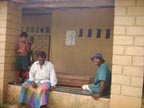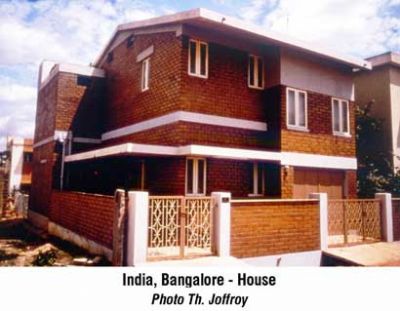


Building with Earth
Links on Stabilized Compressed Earth Blocks (CEB)
Compressed Soil/Earth Brick Resources in Sri Lanka
Sri Lanka should be actively looking into using an construction alternative to cement blocks. Cement block manufacture requires large quantities of sand. The sand is now mainly dug up from riverbeds and has caused severe environmental effects. One of the main causes has been the deepening of rivers to be below sea level, resulting in saltwater intrusion many miles inland. The Gin Ganga in Galle area is now over 40 feet deep and saltwater intrusion occurs as far inland as Baddegama. To counteract this saltwater intrusion, the government is in the process of spending many millions to construct a tidal gate at Gintota.
Using earth as a construction material has now been developed over the world to the point where it is much better than brick. Of the many advantages of using earth is its superb insulation capacity and minimal environmental impact. Earth as building material is quite within the average Sri Lankans grasp, in both technology and cost.
Basically there are three main methods of using earth
a) Wattle and Daub (Warichi)
b) Rammed Earth and Stabilized rammed Earth ( Thappe Bitthi)
c) Stabilized Compressed Earth Blocks
The Stabilized Compressed Earth Block(CEB) making  machine (CINVA-RAM) was first developed by Raul Ramirez of the Inter-American Housing Center (CINVA) in Bogota, Colombia in the 1950's. This is the most advanced of the methods of for using earth in construction. In this technique earth is mixed withcement (30:1) is placed in a metal block and compressed by about 30%. It is as strong as brick and much better heat insulation. A low cost machine w
machine (CINVA-RAM) was first developed by Raul Ramirez of the Inter-American Housing Center (CINVA) in Bogota, Colombia in the 1950's. This is the most advanced of the methods of for using earth in construction. In this technique earth is mixed withcement (30:1) is placed in a metal block and compressed by about 30%. It is as strong as brick and much better heat insulation. A low cost machine w as distributed by the Samudri a few years ago. LEADS a Christian organisation in Dehiwala also has a few of these machines loaned to rehabilitation centers in rural areas of Sri Lanka. We did manage to visit such a place in Nagoda (Near Akmeemana in Galle) and saw it being used and the houses build with the blocks. We were very impressed. (See here for more photos)
as distributed by the Samudri a few years ago. LEADS a Christian organisation in Dehiwala also has a few of these machines loaned to rehabilitation centers in rural areas of Sri Lanka. We did manage to visit such a place in Nagoda (Near Akmeemana in Galle) and saw it being used and the houses build with the blocks. We were very impressed. (See here for more photos)
Clipsal in Sri Lanka is also manufacturing these blocks and selling them at a rate higher than for cement blocks (see advertisement). This would be my material of choice for larger buildings /houses. An organisation in India sells quite a sophisticated machines (using manual labor) to make these blocks. Refer to linked page for futher info on using CEB.
One very important note. We probably would not have been very successful in trying out the wattle and daub and rammed earth construction techniques if not for Sunil Abeywira Gunawardana. Sunil was a local contractor (baas) and part owner of the property Serene Lake purchased in Barathuduwa. Everyone advised us against hiring a local person let alone a former owner to carry out any construction. However, we hired Sunil and was very pleased with the outcome. He was extremely enthusiatic, suggesting various changes and took the initiative in getting together the material need to construct the earth walls.
Rammed Earth and Stabilized Rammed Earth ( Thappe Bitthi )
This method of construction (Rammed Earth) has been used in Sri Lankain the past. But for some reason has not been widespread. A neighbour of Serene Lake in Barathuduwa, has a house built about 50 years ago with this technique. It has been plastered and painted and is indistinguishable from any other upper middle class house of that era.
Stabilized rammed earth, uses construction techniques similar to rammed earth. The only difference being that 1 part of cement is added to 25-30 parts of Earth. We used Stabilized Rammed Earth to build a restaurant in at Serene Lake. We are very satisfied with its look appearance and its strength, and look forward to using more of this method in the future.
Stabilized rammed earth wall have some upfront costs, which are mainly cement and the cost of the shuttering (i.e wood and long bolts to hold the cast).
Wattle and Daub
We have used Wattle and Daub in the construction of two cottages at Barathuduwa, Dodanduwa (www.sereneLake.com). Though we liked the look of the traditional wattle and daub we think there quite a few disadvantages to use of this technique for construction, and its becoming a mainstream technique.
a) There very few people around who know the techniques for construction. The process of making the mud is quite messy and younger generation is reluctant to engage in this process.
b) Its hard to get the walls to a finish where it could be white washed and painted so that the house looks no different from from a brick or cement block house. Also the cracks in the walls tend to allow insect (centipedes (Patthayo) etc) to breed.
c) It takes longer to construct than the next methods of construction. On the flip side there is very little upfront cost needed before construction.

Contact:
Sereno: +94 77-858 4009
Kumari: +94 78-834 9007
wilpattuHouse@gmail.com